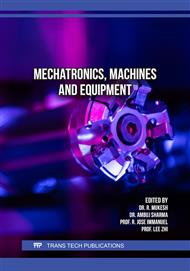[1]
H. Zou, Y. Feng, X. Zhang, T. Ohara, L. Qiu, Enhancing mechanism of cnt-cnt interface by metal nanoparticle and nanowire effect on the inside and outside of cnt, International Journal of Thermal Sciences 185 (2023) 108094.
DOI: 10.1016/j.ijthermalsci.2022.108094
Google Scholar
[2]
D. Toebben, A. Goerner, P. Luczynski, M. Wirsum, W. F. Mohr, K. Helbig, Investigation and thermal modeling of the thermal contact resistance at a steam turbine blade root, in: Turbo Expo: Power for Land, Sea, and Air, Vol. 58646, American Society of Mechanical Engineers, 2019, p. V05AT13A003.
DOI: 10.1115/gt2019-90769
Google Scholar
[3]
C. Courbon, T. Mabrouki, J. Rech, D. Mazuyer, E. D'Eramo, On the existence of a thermal contact resistance at the tool-chip interface in dry cutting of aisi 1045: Formation mechanisms and influence on the cutting process, Applied Thermal Engineering 50 (1) (2013) 1311–1325.
DOI: 10.1016/j.applthermaleng.2012.06.047
Google Scholar
[4]
E. Artyukhin, A. Nenarokomov, A. Tryanin, S. Utenkov, V. Yakovlev, Identification of contact thermal resistances in nuclear reactor fuel elements. 1. algorithm development, Journal of engineering physics 60 (3) (1991) 380–388.
DOI: 10.1007/bf00870882
Google Scholar
[5]
R. R. Kumar, R. Palininathan, E. Kishor, G. S. Kumar, B. Deependran, Role of thermal contact conductance on sandwich-type metallic thermal protection system profile, AIAA journal 50 (10) (2012) 2194–2201.
DOI: 10.2514/1.j051544
Google Scholar
[6]
H. L. Zhao, D. X. Li, Y. M. Huang, F. Gao, J. Yu, B. Wang, D. H. Mu, Experimental research on influence factors of thermal contact resistance between joints, Applied Mechanics and Materials 52 (2011) 1560–1564.
DOI: 10.4028/www.scientific.net/amm.52-54.1560
Google Scholar
[7]
S. R. Narayana, P. K. Narayan, Effect of load and interface materials on thermal contact resistance between similar and dissimilar materials, Applied Mechanics and Materials 592 (2014) 1493– 1497.
DOI: 10.4028/www.scientific.net/amm.592-594.1493
Google Scholar
[8]
M. M. Yovanovich, Four decades of research on thermal contact, gap, and joint resistance in microelectronics, IEEE Transactions on Components and Packaging Technologies 28 (2) (2005) 182–206.
DOI: 10.1109/tcapt.2005.848483
Google Scholar
[9]
A. S. for Testing, Materials, Standard Test Method for Thermal Transmission Properties of Thermally Conductive Electrical Insulation Materials, ASTM International, 2017.
DOI: 10.1520/d5470
Google Scholar
[10]
C. Madhusudana, Accuracy in thermal contact conductance experiments-the effect of heat losses to the surroundings, International communications in heat and mass transfer 27 (6) (2000) 877– 891.
DOI: 10.1016/s0735-1933(00)00168-8
Google Scholar
[11]
E. Ajul, E. Kishor, S. Chanda, Prediction of thermal contact conductance in conforming rough metal contacts through regeneration of surface profile, in: Proceedings of the 26thNational and 4th International ISHMT-ASTFE Heat and Mass Transfer Conference December 17-20, 2021, IIT Madras, Chennai-600036, Tamil Nadu, India, Begel House Inc., 2021.
DOI: 10.1615/ihmtc-2021.2620
Google Scholar
[12]
M. K. Thompson, Methods for generating rough surfaces in ANSYS, in: Proceedings of the 2006 International ANSYS Users Conference & Exhibition, Pittsburgh, PA, Citeseer, 2006.
Google Scholar
[13]
C. Ma, L. Zhao, H. Shi, X. Mei, J. Yang, A geometrical mechanical thermal predictive model for thermal contact conductance in vacuum environment, Proceedings of the Institution of Mechanical Engineers, Part B: Journal of Engineering Manufacture 230 (8) (2016) 1451–1464.
DOI: 10.1177/0954405415611358
Google Scholar
[14]
M. V. Murashov, S. D. Panin, Modeling of thermal contact conductance, in: International Heat Transfer Conference, Vol. 49415, 2010, p.387–392.
DOI: 10.1115/ihtc14-22616
Google Scholar
[15]
P. Siddappa, A. Tariq, Contact area and thermal conductance estimation based on the actual surface roughness measurement, Tribology International 148 (2020) 106358.
DOI: 10.1016/j.triboint.2020.106358
Google Scholar
[16]
J.-J. Gou, X.-J. Ren, Y.-J. Dai, S. Li, W.-Q. Tao, Study of thermal contact resistance of rough surfaces based on the practical topography, Computers & Fluids 164 (2018) 2–11.
DOI: 10.1016/j.compfluid.2016.09.018
Google Scholar
[17]
C. H. Huang, M. Ozisik, B. Sawaf, Conjugate gradient method for determining unknown contact conductance during metal casting, International Journal of Heat and Mass Transfer 35 (7) (1992) 1779–1786.
DOI: 10.1016/0017-9310(92)90148-l
Google Scholar
[18]
S. Chanda, C. Balaji, P. Venkateshan, S, G. R. Yenni, Estimation of principal thermal conductivities of layered honeycomb composites using ann–ga based inverse technique, International Journal of Thermal Sciences 111 (2017) 423–436.
DOI: 10.1016/j.ijthermalsci.2016.09.011
Google Scholar
[19]
G. R. Yenni, S. M. Basha, H. K. Thota, V. Jasvanth, An inverse estimation of thermal contact conductance of aero-space structural adhesive interface between diffuser plate and honeycomb sandwich panel, in: Proceedings of the 26thNational and 4th International ISHMT-ASTFE Heat and Mass Transfer Conference December 17-20, 2021, IIT Madras, Chennai-600036, Tamil Nadu, India, Begel House Inc., 2021.
DOI: 10.1615/ihmtc-2021.3400
Google Scholar
[20]
S. Fathi, M. Eftekhari Yazdi, A. Adamian, Estimation of contact heat transfer between curvilinear contacts using inverse method and group method of data handling (gmdh)-type neural networks, Heat and Mass Transfer 56 (6) (2020) 1961–1970.
DOI: 10.1007/s00231-020-02832-x
Google Scholar
[21]
M. Asif, A. Tariq, K. M. Singh, Estimation of thermal contact conductance using transient approach with inverse heat conduction problem, Heat and Mass Transfer 55 (11) (2019) 3243–3264.
DOI: 10.1007/s00231-019-02617-x
Google Scholar
[22]
E. Ajul, S. Chanda, Estimation of thermal contact conductance of spacecraft heat sink bolted joints, Applied Thermal Engineering 224 (2023) 120078.
DOI: 10.1016/j.applthermaleng.2023.120078
Google Scholar
[23]
E. Kishor, E. Ajul, S. Chanda, S. L. Das, Estimation of spatially varying thermal contact conductance of non-conformal bolted joint, Heat and Mass Transfer (2023) 1–18.
DOI: 10.1007/s00231-023-03436-x
Google Scholar
[24]
S. Sunil Kumar, K. Ramamurthi, Influence of flatness and waviness of rough surfaces on surface contact conductance, Journal of Heat Transfer 125 (3) (2003) 394–402.
DOI: 10.1115/1.1565093
Google Scholar
[25]
Comsol optimization module guide, https://doc.comsol.com/5.4/doc/com.comsol. help.opt/OptimizationModuleUsersGuide.pdf (Aug. 2022).
Google Scholar
[26]
A. Tariq, M. Asif, Experimental investigation of thermal contact conductance for nominally flat metallic contact, Heat and Mass Transfer 52 (2) (2016) 291–307.
DOI: 10.1007/s00231-015-1551-1
Google Scholar


